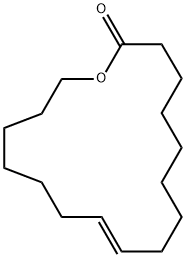Colorless, somewhat viscous oil with rich and
extremely tenacious floral-musky, sweet odor.
Ambrettolide is one of the finest fixatives among the distinguished group of those showing a synergistic and amplifying effect upon perfumes and flavors. At the same time it increases the diffusiveness of fragrances in which it is incorporated. Its fixative effect is easily recognized by the fact that solutions of 0.01% ~ Ambrettolide (or even less) in slightly diluted alcohol show practically no odor of alcohol, only a faint, floral-musky, sweet and pleasant odor of the lactone. A. is particularly useful in fragrance types of delicately floral, mildly animal or Ambre-like type.
AMBRETTOLIDE is not reported as being found in nature, in contrast
to (Z)-7-hexadecen-16-olide, which occurs in ambrette seed oil
and which is also referred to as ambrettolide. It is a colorless to slightly yellow
liquid, d204 0.949–0.957, n20D 1.477–1.482, with an intense and powerful musk
odor. It is prepared by treating aleuritic acid (9,10,16-trihydroxyhexadecanoic
acid) with trimethyl orthoformate to give a dioxolane derivative. Reaction with
acetic anhydride yields ??-acetoxy (E)-9-hexadecenoic acid methyl ester. This is
lactonized with potassium hydroxide to give the title compound .
Found in oil of ambrette seed[Givaudan Index, 1961).
Ambrettolide is a macrocyclic lactone that naturally occurs in ambrette seed oil. Ambrettolide is nontoxic, has a musky odour, and is commonly used as a fixative in perfume formulations.
Many patented methods are known, few are commercially feasible. From Bromo hexadecenoic acid, or from Dihydroxy palmitic acid, or from Aleuritic acid, or from Juniperic acid, etc.
From bromohexadecenoic acid(Bedoukian, 1967).
ChEBI: Isoambrettolide is a macrolide.
Flammability and Explosibility
Not classified


